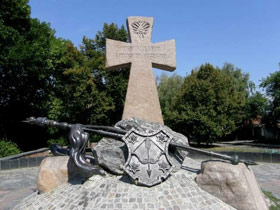|
 The Monument to the Fallen Kozaks was dedicated in
Poltava in September 1994 as a tribute to the Ukrainian
Kozaks who perished during the Great Northern War
of 1700-1721. During the longest military conflict of the
18th century the Ukrainian Kozaks under Hetman Ivan
Skoropadsky fought on the side of the Russian army
of Peter I, while Ukrainian Kozaks under the leadership
of Hetman Ivan Mazepa and Kozaks under the Kish
Ataman Gordienko fought on the side of the Swedish
army of Charles XII. In addition, many Ukrainian Kozaks
were killed in battles far beyond Ukraine, and during the
construction of fortresses, canals, etc. Another tragic page
in the history of the Ukrainian Kozaks was the destruction
of the Fortress of Baturyn, the residence of the Hetman
of Left Bank Ukraine from 1669 -1708.
The Monument to the Fallen Kozaks was dedicated in
Poltava in September 1994 as a tribute to the Ukrainian
Kozaks who perished during the Great Northern War
of 1700-1721. During the longest military conflict of the
18th century the Ukrainian Kozaks under Hetman Ivan
Skoropadsky fought on the side of the Russian army
of Peter I, while Ukrainian Kozaks under the leadership
of Hetman Ivan Mazepa and Kozaks under the Kish
Ataman Gordienko fought on the side of the Swedish
army of Charles XII. In addition, many Ukrainian Kozaks
were killed in battles far beyond Ukraine, and during the
construction of fortresses, canals, etc. Another tragic page
in the history of the Ukrainian Kozaks was the destruction
of the Fortress of Baturyn, the residence of the Hetman
of Left Bank Ukraine from 1669 -1708.
Russian troops under the command of Alexander Menshikov
captured the town of Barutyn on 2 November 1708, killing
about 7,000 of its residents and the 6,000 Ukrainian Kozaks
who defended the fortress. After the victory in the Battle of
Poltava, Tsar Peter I ordered the brutal massacre of those
Kozaks who had allied themselves with the Swedes. The
Monument to the Fallen Ukrainian Kozaks was erected on
Panyanka Boulevard in an area that was part of the Fortress
of Poltava. Panyanka Boulevard ends in a viewing area on
top of steep slopes that offers a beautiful view of the Podil
District and the Exaltation of the Holy Cross Monastery.
The monument was designed by the local sculptor Volodymyr
Bilous and artist Viktor Baturyn. A Kozak cross on top of a
mound bears the inscription: "To the fallen Ukrainian Kozaks."
Near the foot of the mound are two bunchuks (standards),
historically recognized as symbols of the Hetman's power,
and the coat of arms of Poltava, approved by Hetman Bohdan
Khmelnytsky. The opening ceremony was scheduled to
coincide with the celebration of the Intercession of the Mother
of God who has always been considered to be the patron
saint of Ukrainian Kozaks.
|
 History
History
 Dates and events
Dates and events
 Persons
Persons
 Poltava
Poltava
 Sights
Sights
 Photo gallery
Photo gallery
 Maps
Maps
 Virtual Museum
Virtual Museum
 Armament
Armament
 Uniforms
Uniforms
 Coins and medals
Coins and medals
 Flags
Flags
 Paintings
Paintings
 Poltava photographs
Poltava photographs
 News
News
 About us
About us
 Acknowledgments
Acknowledgments
 Main page
Main page
 Photo gallery
Photo gallery
 ...back
...back  History
History
 Dates and events
Dates and events
 Persons
Persons
 Poltava
Poltava
 Sights
Sights
 Photo gallery
Photo gallery
 Maps
Maps
 Virtual Museum
Virtual Museum
 Armament
Armament
 Uniforms
Uniforms
 Coins and medals
Coins and medals
 Flags
Flags
 Paintings
Paintings
 Poltava photographs
Poltava photographs
 News
News
 About us
About us
 Acknowledgments
Acknowledgments
 Main page
Main page
 Photo gallery
Photo gallery